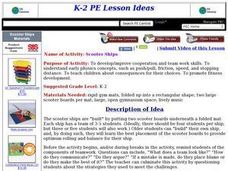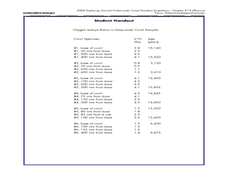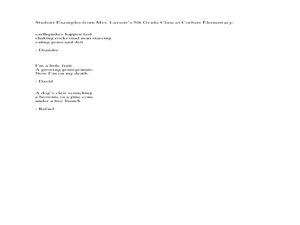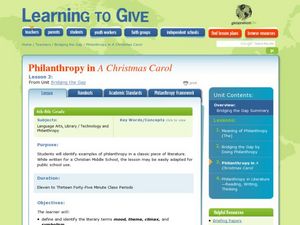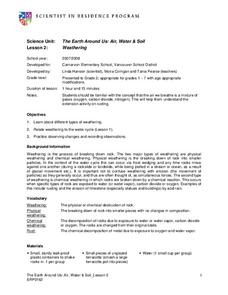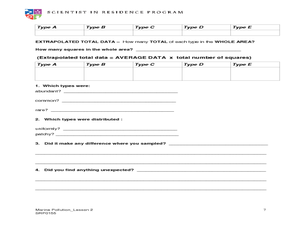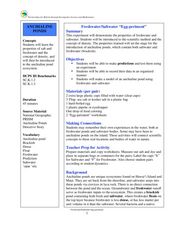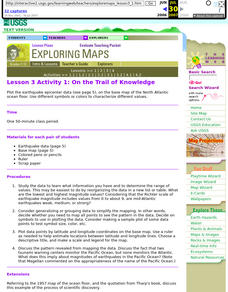Curated OER
State of Alabama
For this reading passages about the state of Alabama worksheet, students read about the state's geography, history, exploration, industry, and people and use the information to answer multiple choice and true and false questions....
Curated OER
Scooter Ships
Students explore simple physics concepts such as push/pull, friction, and speed. In this physics/physical education lesson, students work in co-operative groups to "build" a spaceship out of scooters and folded mats. Teams experiment...
Curated OER
Bad Algae!
Students explore algal blooms. In this ecosystem and health activity, students define and describe harmful algal blooms, then discuss ways in which the impact of these algal blooms could be reduced. Students work in groups to...
Curated OER
How can deep-water corals be used to determine long-term patterns of climate change?
Students explore the concept of paleoclimatological proxies. For this paleoclimatological proxies lesson, students explain isotope ratios in deep water coral samples. Students write a paragraph about global climate change as...
Curated OER
Climate Change: Is there a Controversy
Students explore climate changes. For this climate changes lesson, students research what causes changes. Students search the Internet, summarize reports they find and create a poster with the information.
Curated OER
Take a Breath, Steal Some Time
Students explore the art of haiku's by listening to, modeling and creating them. In this haiku poetry lesson, students choose an object to focus their haiku on. After hearing a brief history of the haiku; students make...
Curated OER
City Life In Europe
Students explore Paris. In this geography skills lesson, students watch "City Life in Europe," and conduct further research on the city of Paris and the country of France. Students create postcards that feature Parisian landmarks.
Curated OER
Surface Area and Measuring
Tenth graders explore volume and surface area through percentages. In this geometry instructional activity, 10th graders analyze the surface area of two and three dimensional shapes, then use percents and ratio to compare the two.
Curated OER
Under the Blood-Red Sun
Fifth graders explore U.S. history by reading an award winning book about World War II. In this Japanese internment camp lesson, 5th graders read the book Under the Blood-Red Sun and discuss the entrapment of Japanese-Americans on our...
Curated OER
River System
Fifth graders explore the parts of a river system and understand the importance of each part. For this river system lesson, 5th graders diagram a river system and write a paragraph explaining its parts.
Curated OER
The Wonders of Bacteria
Students explore the evolution and features of bacteria through a series of activities. In this biology lesson plan, students collect data and graph bacterial growth. They design a brochure about bacteria's role in society.
Curated OER
Ping!
Seventh graders study side-scan sonar and discover how it can be used to locate objects underwater. They complete a sonar simulation activity in which they create and map mystery landscapes inside shoeboxes.
Curated OER
Designing a Study
Students explore features to consider when designing a scientific study. For this science research lesson, students examine different methods of data collection and consider which method would be appropriate for determining how many...
Curated OER
Is the Hudson River Too Salty to Drink?
Students explore reasons for varied salinity in bodies of water. In this geographical inquiry lesson plan, students use a variety of visual and written information including maps, data tables, and graphs, to form a hypothesis as to why...
Curated OER
Philanthropy in A Christmas Carol
Students explore philanthropy in literature. For this cross curriculum literacy and character development lesson, students read A Christmas Carol by Charles Dickens and note charitable acts described in the story. Students relate story...
Curated OER
Extreme Weather
Students examine different types of extreme weather and how to prepare for them. In this weather lesson students explore different types of extreme weather and create disaster preparation posters for different types of extreme weather.
Curated OER
Weathering
Second graders explore weathering and how the water cycle plays a part in weathering. For this weathering lesson, 2nd graders put gravel and sugar cubes in a jar and shake, simulating weathering. Students use the scientific method...
Curated OER
Scientific Sampling
Students take a sample of fish and try to determine how many fish are in the sea. In this scientific sampling lesson, students explore the way scientists measure large areas of samples. Students record the distribution in a quadrant.
Curated OER
Earth Energy Budget Pre Lab
Learners explore energy by conducting an in class experiment. In this climate change instructional activity, students conduct a water vapor experiment in a soda bottle. Learners utilize graphs and charts to analyze the results of the...
Curated OER
Freshwater/Saltwater "Eggs-Periment"
Learners explore water properties by conducting a class experiment. In this buoyancy instructional activity, students utilize freshwater, saltwater, plastic cups, hard boiled eggs and food coloring to experiment with the floating...
Curated OER
Coral Reef Community
Students explore the coral reef. In this food chain lesson plan, students study the plants and animals of the coral reef and how they each play a role in that ecosystem. They participate in a class play to demonstrate the types of...
Curated OER
Fish Fashion 101
Students explore fish anatomy. In this fish anatomy and adaptation lesson plan, students define and identify the location of fish body parts. Students add these parts of a fish's anatomy to a life-sized fish costume worn by a...
Curated OER
Lesson 3 Activity 1: On the Trail of Knowledge
Students plot the earthquake epicenter data on the base map of the North Atlantic ocean floor using different symbols or colors to characterize different values.
Curated OER
Food Web Mystery
Students describe typical marine food webs, and explain why food is generally scarce in the deep-ocean environment. They discuss reasons that seamounts may support a higher density of biological organisms than would appear to be possible.
Other popular searches
- Ocean Exploration Tools
- Pacific Ocean Exploration
- Ocean Exploration Food Web
- Ocean Exploration Technology
- Bill Nye Ocean Exploration
- Ocean Exploration Time Lines
- Human Ocean Exploration
- Ocean Exploration Time Lime
- Bill Nye: Ocean Exploration
- Ocean Exploration Expeditions
- Ocean Exploration Timelime

